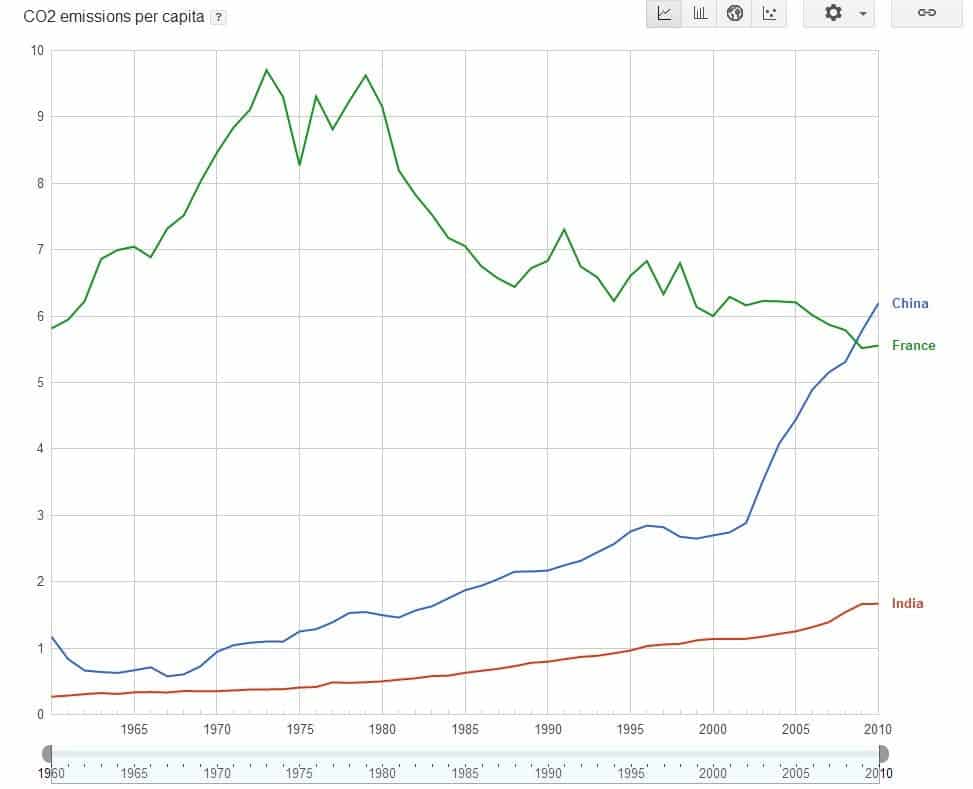Despite significant steps towards a more sustainable future, China is still the world’s most polluting country – and it’s not only their sheer population that’s the cause. A new study conducted by two British researchers revealed that China emits more CO2 per capita than Europe. They also estimate that we have already released two thirds of the fossil-fuel emissions allowable under scenarios that avoid irreversible changes to the planet.
“We are nowhere near the commitments needed to stay below 2 degrees Celsius of climate change, a level that will be hard to reach for any country, including rich nations,” said Corinne Le Quere, co-author of the report and a director of the Tyndall Center for Climate Change Research at the University of East Anglia, England. “CO2 growth now is much faster than it was in the 1990s, and we’re not delivering the improvements in carbon intensity we anticipated 10 years ago.”

Google puts a myriad of interesting stats and data available for free access (https://www.google.com/publicdata/explore). The data is from the World Bank.
In 1990, China emitted 2.2 tons of metric CO2 per capita per year, while the European Union was responsible for 4 times more – 8.8 metric tons. In 2000, the situation was not much different. China had slightly increased its emissions (2.7), while the EU had dropped its(8.2). However, in 2013, the situation was very different. The average for each person in China is 7.2 tons, while in Europe, that figure is 6.8. The US accounts for much more than that (16.4 tons), while India is responsible only for 1.9 tons per person.
The study was conducted by Tyndall Center and the University of Exeter’s College of Mathematics and Physical Sciences. China has surpassed the US in terms of net emissions (not per capita) seven years ago, and they never went back. China has argued time and time again that they should not be judged in terms of raw emissions, but in per capita terms. Well, there goes that.
“It is unfair to blame China just based on its carbon emissions,” said Dai Xingyi, a professor at the Department of Environmental Science and Engineering at Fudan University in Shanghai. “Because China has a huge population that has been dependent on coal for a long time, it will not quit using coal in the foreseeable future.”
Indeed, China has reduced their coal consumption, and their economy has still grown – a sign that the economic growth is slowly detaching from coal consumption. Yet CO2 emissions are still on the rise.
This has major implications on a global level too. Temperatures have already increased by 0.85 of a degree since 1880, and the current trajectory puts us on course for a warming of at least 3.7 degrees Celsius by 2100 (about 8 Fahrenheit). Even in the most optimistic scenarios, we’re still going to have to deal with a warming of 1.9 degrees Celsius.
“The time for a quiet revolution in our attitudes toward climate change is now over,” said Pierre Friedlingstein, a University of Exeter professor who was lead author of a paper on the issue in the journal Nature Geoscience.
In order to keep warming under 2 degrees Celsius, the CO2 emissions would have to drop by 5 percent or more (on a global level) for several decades.
Journal Reference: P. Friedlingstein,R. M. Andrew,J. Rogelj,G. P. Peters,J. G. Canadell,R. Knutti,G. Luderer,M. R. Raupach,M. Schaeffer,D. P. van Vuuren& C. Le Quéré. Persistent growth of CO2 emissions and implications for reaching climate targets. Nature Geoscience (2014) doi:10.1038/ngeo2248










